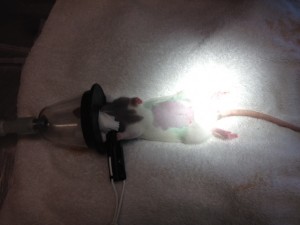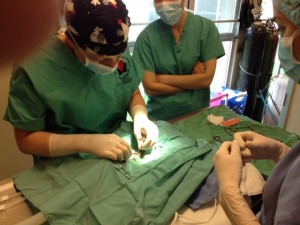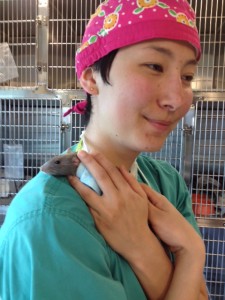 Just when you think you’ve got the routine down, a very small patient shows up on your surgery list. Next thing you know you find yourself researching anesthetic protocols for rats. Most shelters require dogs and cats to be spayed or neutered prior to adoption. Should we have the same recommendation for rats? Well, when you consider how prolific rats are, it could be argued that overpopulation is a concern. Rats can go into heat as early as 5 weeks, they have a heat cycle every 4-6 days, their gestation period is 22-23 days, their average litter size can vary from 2-20 kittens, and they have a postpartum estrus cycle 24 hours later …..well you do the math. Before you know it, an uneducated owner could go from two rats to rat hoarder.
Just when you think you’ve got the routine down, a very small patient shows up on your surgery list. Next thing you know you find yourself researching anesthetic protocols for rats. Most shelters require dogs and cats to be spayed or neutered prior to adoption. Should we have the same recommendation for rats? Well, when you consider how prolific rats are, it could be argued that overpopulation is a concern. Rats can go into heat as early as 5 weeks, they have a heat cycle every 4-6 days, their gestation period is 22-23 days, their average litter size can vary from 2-20 kittens, and they have a postpartum estrus cycle 24 hours later …..well you do the math. Before you know it, an uneducated owner could go from two rats to rat hoarder.
Studies have also shown that spaying rats can reduce the risk of developing mammary tumors and pituitary tumors. Pituitary tumors are hormonally induced, so by removing the source of estrogen, their development can be decreased. In turn, mammary tumors are avoided as they are usually a result of the pituitary tumor. This may provide a longer life span and higher quality of life. Although studies haven’t been conclusive for male rats, neutering could still be performed if there was a chance of co-housing with females.
Surgically, the procedures are very similar to kittens. So surgeons experienced in high-quality, high volume, spay and neuter (HQHVSN) and pediatric spay/neuter may feel a natural segue into rat surgery. However, rats can have a higher anesthetic risk creating the need to keep surgery time as short as possible. Drug doses are very different from dogs and cats so calculations need to be exact. Also, rats are chewers. So avoiding tissue glue or anything overtly irritating along the incision is essential to prevent self- trauma and dehiscence. But one of the biggest considerations is providing safe and low stress handling of rats before, during and after the procedure. Therefore, the comfort level of the veterinarian, technicians and staff are of the utmost importance.
References are essential and two very good ones to have on hand are:
Ferrets, Rabbits, and Rodents: Clinical Medicine and Surgery, 3e Paperback
by Katherine Quesenberry DVM MPH Diplomate ABVP (Author), James W. Carpenter MS DVM Dipl ACZM (Author)
Exotic Animal Formulary, 4e
by James W. Carpenter (Author)
Acquainting yourself with local exotic veterinarians and rat rescue groups can also be a valuable resource. Along with advice, they may be able to assist with adoption, or provide help if rat intake is not an option. If there is a veterinary teaching hospital in your area they most likely have an exotics department. The Association of Exotic Mammal Veterinarians website allows you to search by state to find a member veterinarian at http://www.aemv.org/vetlist.cfm. Also http://mainelyratrescue.org/rattieblog2/?page_id=54, and http://www.ratchickratrescue.com/links.html#rescues have helpful rescue links and allow you to search for rescue groups by state.
Rats are social and intelligent companions who, unlike other rodents, don’t have a strong desire to latch onto your fingers when handling. This, along with their hardiness, make them ideal pets for children and adults and are definitely worth the added research.

